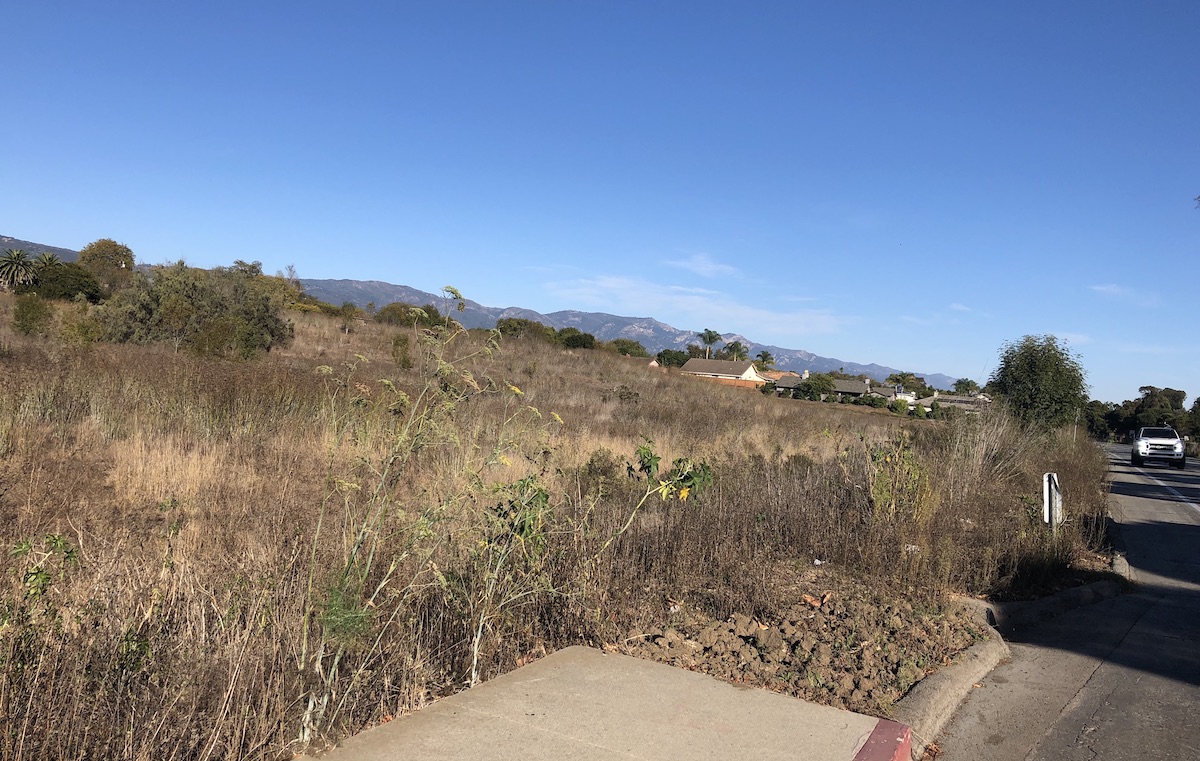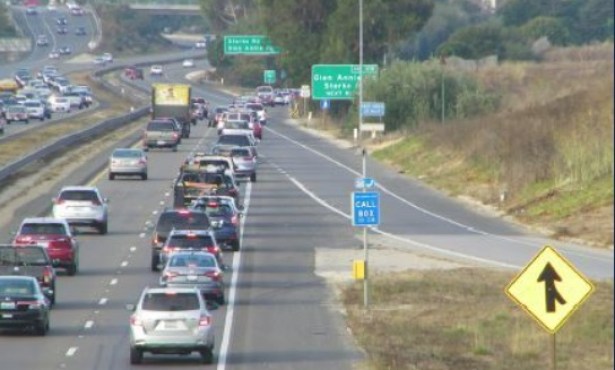Parcels to Be Rezoned at Goleta Planning Commission
City’s Housing Element Project to Consider 11 Property Rezones

[Update: Nov. 13, 2023, 9 p.m.] The scheduled meeting was moved to Wednesday, November 15, on short notice. Public comment was taken, though no rezoning votes took place.
[Original Story] Goleta plans to be on track to add 1,837 new homes over the next eight years, part of the city’s effort to satisfy California’s push to reach the building of 180,000 homes annually. Goleta’s Planning Commission takes its turn to attack the problem at the local level during a series of rezoning discussions and votes on Monday evening concerning 11 properties on the city’s much-debated rezoning list.
For neighbors of some of the parcels, the implication is clear: Their small patch of wilderness is going to hold apartment buildings.
Next door to the Kenwood Village project at 7264 Calle Real, April Reid lives in the house her parents built 57 years ago. Her great-grandmother, after whom the street is named, lived in the house next to Reid’s.
Set along the Highway 101 frontage road known as Calle Real between Glen Annie and Winchester Canyon Road, Kenwood’s 9.68 acres was once part of a large tract owned by the Archdiocese of Los Angeles. Currently zoned for single-family dwellings, the city is planning to increase that to high-density residential, a low-income category that could put 20-30 units per acre.
“I grew up playing in that field when it had pumpkins and tomatoes growing in it,” Reid said, recalling how her parents’ car would get stuck in the mud sometimes before the street was paved. She sees hawks, finches, snakes, skunks, ’possums, and voles on a regular basis at the field. El Encanto Creek runs along the western side of the property, and Reid said her neighbor has photographed a great egret in her yard and monarch butterflies crossing from the Kenwood lot.
Though Reid hopes the creek will be protected, she has other concerns for the new neighbors she might gain. “If the owner builds senior housing, they have difficulty with mobility. What if there’s an emergency?” she asked. Reid has also recorded at least three fatal accidents on Calle Real close to Baker Road since 2008, including a 59-year-old bicyclist killed by a drunk driver in 2020.
Reid isn’t alone in her concerns. Rich Foster lives a few blocks away and is a regular at City Council meetings, with a voluminous memory and a direct manner. He’s read the state’s Housing and Community Development (HCD) guidelines and believes the Kenwood property ill-suited for low-income residents.
“There used to be a bus the kids could take to the junior high school, but it stopped running. There’s no transit, no grocery stores, no bike path on Calle Real, and traffic is a measurable problem,” he said, reciting a few of the state’s criteria for high-density, low-income housing.
The Housing Squeeze
California not only lacks housing — of the 180,000 deemed necessary each year, only 80,000 were built annually over the past decade — the state lacks affordable housing in particular. Goleta, which has seen hundreds of market-rate homes go up in recent years, is required to zone for at least 1,006 new homes that will be affordable to low- and very low-income individuals and families. The state considers high-density housing to be less expensive, and thus affordable to households with small incomes.
For any California city or county under pressure over housing — the shortage of which affects rent prices, homeownership, homelessness, and the cost of living, according to HCD — their task is to zone to a density to meet their required housing numbers. Actual building of the homes remains up to property owners and developers, who themselves face mounting construction costs and bank loan charges.
It’s taken longer than two years for Goleta to reach this point, after workshops, meetings, outreach, phone calls, and personal engagement across the city. Goleta prizes its open spaces, so the city’s first effort concentrated on infill development — which would place new housing among commercial properties — but the tactic was questioned by the state because Goleta had no history of similar projects. The city’s consultants and HCD advised looking at vacant properties, and the state in particular wanted to know that those property owners had an interest in building homes.
Though the rezoning is likely to proceed before any bulldozer rolls onto any property, all the city’s permit and planning rules will continue to hold sway. Goleta Planning Manager Anne Wells was clear: “Any future project would undergo case processing, design review, environmental review, and related public input.”
High-Density Cap
As the City Council and Planning Commission discussed the state-mandated Housing Element this summer, as far as rezoning Kenwood, they decided that if the parcel was to be high density, they’d put a cap of 190 units in an attempt to rein in some of the traffic and other issues. Property owner Ken Alker has a problem with the cap.
“Look at it this way,” said Alker, who bought the lot about 16 years ago. “If it’s 9.6 acres and the density is 20 units per, that’s about 193 units total. If the cap is 190, where am I supposed to go?”

Alker is an electrical engineer by training, arriving in the area in 1987 to study at UC Santa Barbara. His day job is running Impulse Advanced Communications, which is an internet service provider that merged with Silicon Beach and NetLogic in 2006. An affable conversationalist, Alker said he’d thought long and hard about how to set homes on the parcel — in fact, he said Kenwood got its name when his friends would ask, “Who in their right mind would develop that lot?” and answer, “Ken would.”
He had 60 single-family homes “in his brain” for six or seven years for the parcel, which rises at its northeast section before sloping toward the creek, or drainage ditch, as Alker regards it. He was working on it with his father, an architect, and Goleta’s planning staff, when he got a call asking if he’d considered a higher density. “That was just a week ago!” he exclaimed hyperbolically, adding that he really hadn’t had time to consider what he could do, but he didn’t like the stricture a cap was imposing.
That particular cap would impede his senior housing idea. Alker said he’d moved a friend into Friendship Manor recently, where he learned the senior living facility wanted to expand for better wheelchair mobility. That started him thinking about rebuilding Friendship Manor at Kenwood Village and putting workforce housing to the north and east — his own engineers kept leaving for other states, Alker said. But Friendship Manor holds 214 units, which the cap would frustrate, Alker said, but he hoped a new configuration would allow some creativity.
Creeks and Buffers
At least 12 creeks run through Goleta from the mountains to the sea, and El Encanto flows from the foothills to Devereux Slough. Goleta’s creek setback is 100 feet, and the city has public right-of-way and easement setbacks, as well. These combine to make the buildable acreage at Kenwood 6.33 acres, Wells said. Between the site cap and the high-density count of 20 to 30 units per acre, the range of units possible is 126 to 190.
“The 190-unit cap is proposed to recognize the site characteristics, the need to provide adequate buffer from adjacent uses, the need to accommodate site access, and to allow for innovative site planning techniques,” said Wells.
Creeks have been flowing since California’s good winter of rains, too good at times for some flooded areas. But it means the aquifer below Goleta is filling, which the Goleta Water District anticipates will allow it to lift the moratorium on new water meters sometime this year. Although Kenwood had a small agricultural entitlement of less than two acre-feet per year, ag water cannot be converted to residential uses because of 1988’s Measure J. If a 190-unit project were proposed, it would need about 28 acre-feet per year, said Ryan Drake, who manages water supply for the district. Altogether, if restrictions end, the district could allocate as much as 154 acre-feet in 2024, he said.
Goleta’s Planning Commission meets at 6 p.m. on Monday, November 13, to vote on the Housing Element zoning proposals. The meeting will be held in person at City Hall, 130 Cremona Drive, and by video conference. More information is available at https:///cityofgoleta.org/goletameetings. Written comments may be submitted at cityclerkgroup@cityofgoleta.org.
Up for discussion are rezones of the following parcels:
• 60 Colusa Avenue (APN 077-155-004) – Intersection Commercial (CI) to High-Density Residential (RH)
• 7264 Calle Real (Kenwood Village) (APN 077-130-006) – Single-Family Residential (RS) and Agriculture (AG) to RH. For this parcel, HE 2.1(a) also includes a development cap of 190.
• 7190 Hollister Avenue (APN 073-030-005) – Medium-Density Residential (RM)/General Commercial (CG) to RH
• Parcels to East of 7190 Hollister Avenue (APN 073-030-009 and APN 073-030-006) – CG/RM to RH
• 625 Dara Road (APN 069-373-064) – RS to RM
• 35 Ellwood Station Drive (APN 079-210-066) – CG to RH
• 6470 Hollister Avenue (APN 073-070-034) – CG to Community Commercial (CC)
• 7020 Calle Real (APN 077-155-003) – Intersection Commercial (CI) to CC
• 7360 Hollister Avenue (APN 073-020-003, APN 073-020-034, and APN 073-020-035) – CC to RH
• 490 South Fairview (Yardi) (APN 071-130-084) – Business Park (BP) to RH Overlay. An “RH Overlay” is proposed to allow an RH development on the site should the property owner choose to do so.




You must be logged in to post a comment.